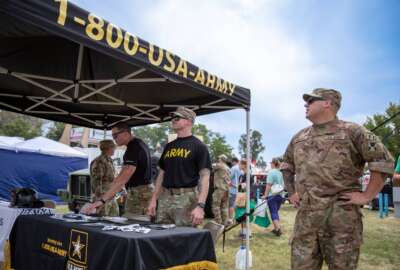Army rebounds from recruiting slump, slightly exceeds target goals
The service recruited 55,300 new soldiers in fiscal 2024, meeting its recruitment target, after it hoped to bring 60,000 recruits in 2022 and 65,000 in 2023.
The Army said Thursday it has met its recruiting goals this year following a historic slump that prompted the service to invest in its recruiting workforce and expand its preparatory course in hopes of turning the tide.
The service recruited 55,300 new soldiers in fiscal 2024, exceeding its goal by 300 recruits. Maj. Gen. Johnny Davis, who leads the Army’s recruiting command, said the Army has also placed approximately 11,000 soldiers into its delayed entry program, giving recruiters a “nice breathing room and a head start” going into fiscal 2025. The delayed program allows soldiers to enlist and delay their active duty start date to finish high school or college.
In fiscal 2022, the Army set a recruiting goal of 60,000 new soldiers but managed to enlist only 45,000 recruits — the shortfall of about 25% was one of the largest recruitment gaps in recent history. In 2023, the service aimed to bring in 65,000 recruits but missed the target by 11,000 soldiers.
The Army seeking to recruit 55,000 soldiers in 2024 after it was hoping to bring in 60,000 recruits in 2022 and 65,000 in 2023 comes after the service announced its plans to shrink the size of its force by about 24,000 troops — Army Secretary Christine Wormuth said at the time of the announcement the service was looking to get rid of already empty positions that were created to support counterinsurgency operations but are no longer needed given shifting strategic priorities.
Recruitment tools, programs
Of all the significant changes and updates in recent years aimed at turning things around, the future soldier preparatory course seems to be yielding the best results — in fiscal 2024 alone, about 16,000 soldiers have joined the Army after graduating from the program.
Kicked off as a pilot in 2022, the prep course helps recruits meet academic or fitness requirements so they can proceed to basic training. Following the successful rollout — it also boasts a 90% success rate — the Army has since expanded the program.
“What this is allowing us to do is to increase the opportunity to serve without sacrificing quality, and those individuals, for whatever reason, just needed that additional time, whether academically or from a fitness perspective, to meet our standards. And those who don’t meet the standards do not matriculate into the initial military training. They never make it the basic training if they don’t meet the standards,” Brig. Gen. Jennifer Walkawicz of the Army Training and Doctrine Command told reporters Thursday.
The Army continues to leverage the soldier referral program — has generated over 75,000 referrals, with 5,000 people joining the service.
The service is also in the midst of transforming its recruiting workforce — the first cohort of warrant officers to ever obtain a military occupational specialty in recruiting graduated this summer. These officers will focus solely on talent acquisition and retention, data analytics, labor market analysis and marketing — a turning point in how the service recruits prospective soldiers.
Davis said the Army Recruiting Command is also experimenting with artificial intelligence — a new AI tool provided by Deloitte helping recruiters generate highly refined prospect lists.
“If there are traits or things that would say, I’m a football player, or I like a number of different sports, I’m a runner. They will help us with that in terms of looking at that applicant pool. So when our recruiters talk to them, they can talk to them given that that background information, instead of what we’ve been doing in the past is really taking a high school list and cold calling, you know, two or 300 high school seniors. That is what we have to get away from, we have to expand,” said Davis.
Copyright © 2025 Federal News Network. All rights reserved. This website is not intended for users located within the European Economic Area.






